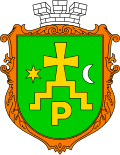Top Qs
Timeline
Chat
Perspective
Romny
City in Sumy Oblast, Ukraine From Wikipedia, the free encyclopedia
Remove ads
Romny (Ukrainian: Ромни, IPA: [romˈnɪ] ⓘ) is a city in Sumy Oblast, northern Ukraine. It is located on the Romen River. Romny serves as the administrative centre of Romny Raion and hosts the administration of Romny urban hromada, one of the hromadas of Ukraine. Population: 37,765 (2022 estimate).[1]
Remove ads
History
Summarize
Perspective
The city was founded in AD 902. On September 16, 2002, the city celebrated its 1,100th anniversary. Romny was first mentioned in documents in 1096 (as Romen, Cyrillic: Ромен; the name, originally that of the river, is of Baltic origin, cf. Lithuanian romus 'quiet'[2]). At various times, it passed under Mongol, Lithuanian, Polish and Russian rule. By 1638, the city had a population of 6,000 inhabitants, which made it by far the largest settlement in the area. In 1781, the city was granted a charter by the Tsarina Catherine II.
Romny was the terminus of the Libau-Romny railway which was built to deliver Ukrainian goods, mostly grains, for export. It also served as main route for emigration to the Americas through the Libau post where passenger ships were accessed.
In Romny the first statue of Taras Shevchenko was erected on 27 October 1918 when the city was located in the newly established Ukrainian state. It was preserved as part of the Soviet Union Ukrainization policies.[3] The concrete statue in Romny began to decay in the 1950s, but was remade in bronze and re-unveiled in 1982.[3] The original version of the monument is located on Kyiv's Andriyivskyy Descent.[3]

Unimaginable suffering was inflicted on the people of Romny during the years of Bolshevik rule, two world wars, famines, and repressions.[4] During the Holodomor of 1932–1933, organized by the Soviet authorities, at least 2274 residents of the city died.
During World War II, Romny was occupied by the German Army from September 10, 1941, to September 16, 1943. The Germans operated a Nazi prison, the Dulag 112 transit prisoner-of-war camp and a subcamp of the Dulag 124 transit POW camp in the city.[5][6]
In the period between 1979 and 1989, Romny's population rose from 53,016 to 57,502 inhabitants.

In 2022, a series of military engagements occurred near Romny during the 2022 Russian invasion of Ukraine.
Remove ads
Population
Ethnicity
According to the 2001 Ukrainian census, the city had a population of 49,935 inhabitants. The ethnic composition was as follows:[7]
Language
Distribution of the population by native language according to the 2001 census:[8]
Remove ads
Geography
Climate
Sights
The cathedral of the Holy Spirit, founded in 1735 in place of a wooden church, is a four-pillared cathedral designed in the Ukrainian Baroque style and is surmounted by three pear-shaped domes, each placed on a tall cylinder. Although the cathedral dates back to the 1740s, the building of the nearby belfry and winter church was not undertaken until 1780.
Another noteworthy building is the church of the Ascension, which also has three domes, but was constructed later, in 1795–1801, and adjoins a Baroque belfry built in 1753–63.
Remove ads
Local government
Beside the city itself, the city municipality also serves as government for a village Kolisnykove and a settlement Luchky.
The city also has administration of the surrounding Romny Raion.
Notable people
- Yevhen Adamtsevych (1904-1972), prominent blind Ukrainian bandurist
- Haim Arlosoroff (1899–1933), notable Socialist Zionist leader
- Maksym Biletskyi (born 1980), Ukrainian footballer
- Larisa Netšeporuk (born 1970), heptathlete who represented Ukraine and Estonia
- Pinhas Rutenberg (1879–1942), Russian socialist revolutionary and Zionist leader in Palestine, prominent engineer and businessman
- Isaac Schwartz (1923–2009), Soviet composer
- Grigory Sokolnikov (born Hirsch Brilliant; 1888–1939), Bolshevik revolutionary and Soviet politician
- Joachim Stutschewsky (1891–1982), Austrian and Israeli cellist, composer, and musicologist
- Abram Ioffe (1880–1960), prominent Russian/Soviet physicist
- Several of the founding members (1909–10) of Degania, the first kibbutz settlement in Palestine
Remove ads
Gallery
- Downtown Romny
- Ascension Church
- Palace of Culture
- Former seminary
- Roman Catholic church of the Immaculate Conception
- Former trading house
- Historical school building
- Taras Shevchenko monument
- Steam mill in Romny
- District hospital building
- High school building
- Church of All Saints in Romny
- Historic hospital building
- Bus station in Romny
References
External links
Wikiwand - on
Seamless Wikipedia browsing. On steroids.
Remove ads



















